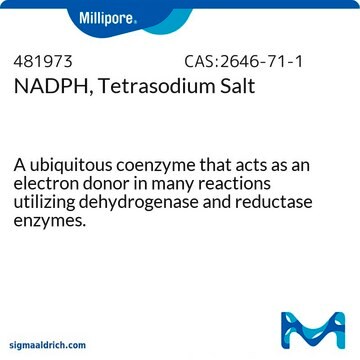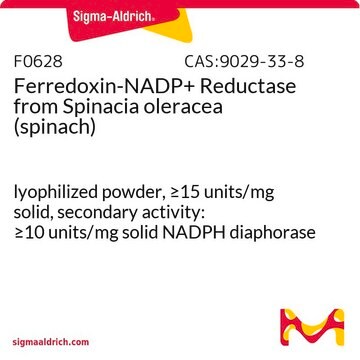No, this product does not contain FAD and is not FAD-dependent. This product is Glucose 1-Dehydrogenase, as such this is an NAD dehydrogenase.
19359
Glucose dehydrogenase from Pseudomonas sp.
powder, white, ≥200 U/mg
Synonyme(s) :
GDH
Sélectionner une taille de conditionnement
217,00 €
Sélectionner une taille de conditionnement
About This Item
217,00 €
Produits recommandés
Source biologique
bacterial (Pseudomonas spp.)
Forme
powder
Activité spécifique
≥200 U/mg
Caractéristiques du produit alternatif plus écologique
Waste Prevention
Design for Energy Efficiency
Learn more about the Principles of Green Chemistry.
sustainability
Greener Alternative Product
Couleur
white
Autre catégorie plus écologique
, Enabling
Température de stockage
−20°C
Catégories apparentées
Description générale
Application
Actions biochimiques/physiologiques
Définition de l'unité
Code de la classe de stockage
11 - Combustible Solids
Classe de danger pour l'eau (WGK)
WGK 3
Point d'éclair (°F)
Not applicable
Point d'éclair (°C)
Not applicable
Équipement de protection individuelle
Eyeshields, Gloves, type N95 (US)
Faites votre choix parmi les versions les plus récentes :
Déjà en possession de ce produit ?
Retrouvez la documentation relative aux produits que vous avez récemment achetés dans la Bibliothèque de documents.
-
Does this GDH contain FAD?
1 answer-
Helpful?
-
-
Does this product contain co-factor NADH?
1 answer-
NADH is already present as a cofactor in this product, so there is no need to add it.
Helpful?
-
-
What solvent can Product 19359, Glucose dehydrogenase be dissolved in? How should it be stored?
1 answer-
Glucose Dehydrogenase can be dissolved in a solvent such as a phosphate buffer or Tris-HCl buffer. The product must be stored in a cool, dry and well-ventilated place with the container tightly closed. Recommended Storage temperature is -20°C.
Helpful?
-
Active Filters
Notre équipe de scientifiques dispose d'une expérience dans tous les secteurs de la recherche, notamment en sciences de la vie, science des matériaux, synthèse chimique, chromatographie, analyse et dans de nombreux autres domaines..
Contacter notre Service technique








